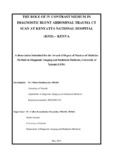| dc.contributor.author | Dusabeyezu, Fidens | |
| dc.date.accessioned | 2016-11-18T06:20:58Z | |
| dc.date.available | 2016-11-18T06:20:58Z | |
| dc.date.issued | 2015-05 | |
| dc.identifier.uri | http://hdl.handle.net/11295/97511 | |
| dc.description.abstract | Background: Previous studies have proven the intravenous contrast CT to be the cornerstone
of the diagnostic work-up of abdominal trauma, essentially for evaluating solid parenchymal
and vascular injuries. This study was aimed at determining the utility of IV contrast medium
in diagnostic blunt abdominal trauma CT scan at Kenyatta National Hospital (KNH), since IV
contrast medium was not routinely used in KNH for blunt abdominal trauma CT scan.
Methods: A standard questionnaire was used to record the socio-demographic characteristics
of the study participants, the mode of trauma and CT scan findings. All patients sent for
initial diagnostic abdominopelvic CT scan with recent history of blunt abdominal trauma,
who could receive IV contrast medium and who consented participation over the study period
made the study population. Each participant underwent at least two consecutive scans, one
scan without IV contrast medium and another one with IV contrast medium for comparison
of findings. For IV contrast scans a portal venous phase scan at 65 seconds and a delayed
phase scan at 5 minutes after starting IV contrast injection were acquired to every patient in
our study.
Results: Thirty nine patients were enrolled into the study. The male to female ratio was
3.8:1. Twenty one patients (53.9%) were in the age group of 21-40 years. Thirty patients
(76.9%) sustained abdominal injuries following motor traffic accidents.
The spleen was the most commonly injured organ (41%), followed by the liver (38%) and the
kidneys (15%). Hemoperitoneum was the most common CT finding (17 patients) and out of
115 injuries registered in our study, pre contrast scans could only detect 45 injuries which
correspond to 39.1% (95 % CI 30.2 – 48.7). This means that 60.9% (95% CI 51.3 – 69.8) of
injuries would have been missed without contrast injection.
Conclusion: The use of IV contrast medium assisted in the demonstration of 60.9 % (95% CI
51.3 – 69.8) of injuries that would have been missed without contrast injection. This confirms
the usefulness of IV contrast injection in blunt abdominal CT scan.
Recommendations: In order to reach definite conclusions larger series are needed.
Diagnostic protocol for management of patients with blunt abdominal injuries should be
made and be available for guiding radiologists and surgeons on management of patients with
abdominal injuries.
A study to evaluate the accuracy of CT scan in the detection of blunt abdominal injuries by
comparing CT findings and operative findings is needed. | en_US |
| dc.language.iso | en | en_US |
| dc.publisher | University of Nairobi | en_US |
| dc.rights | Attribution-NonCommercial-NoDerivs 3.0 United States | * |
| dc.rights.uri | http://creativecommons.org/licenses/by-nc-nd/3.0/us/ | * |
| dc.title | The role of iv contrast medium in diagnostic blunt abdominal trauma CT scan at Kenyatta National Hospital (KNH) – Kenya | en_US |
| dc.type | Thesis | en_US |
| dc.description.department | a
Department of Psychiatry, University of Nairobi, ; bDepartment of Mental Health, School of Medicine,
Moi University, Eldoret, Kenya | |



